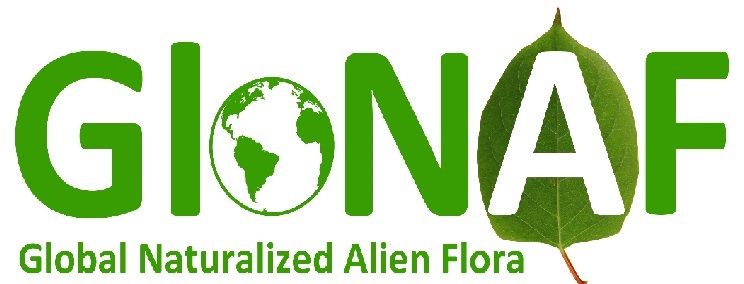
GloNAF (Global Naturalized Alien Flora) is a living database project about naturalized alien plant species and became a synonym for many related projects dealing with all kinds of scientific and policy relevant questions and studies about alien species (also other taxa) and related data (Contact).
Data Overview
The GloNAF database version 1.2 includes 13,939 taxa which accounts for approx. 4% of the extant global flora. Spatially, GloNAF covers 1,029 regions (including 381 islands) including all terrestrial regions of the globe. For an overview of the information covered in GloNAF see Pyšek et al. (2017)
Pyšek P, Pergl J, Essl F, Lenzner B, Dawson W, Kreft H, Weigelt P, Winter M, Kartesz J, Nishino M, Antonova LA, Barcelona JF, Cabezas FJ, Cárdenas D, Cárdenas-Toro J, Castaño N, Chacón E, Chatelain C, Dullinger S, Ebel AL, Figueiredo E, Fuentes N, Genovesi P, Groom QJ, Henderson L, Inderjit, Kupriyanov A, Masciadri S, Maurel N, Meerman J, Morozova O, Moser D, Nickrent D, Nowak PM, Pagad S, Patzelt A, Pelser PB, Seebens H, Shu WS, Thomas J, Velayos M, Weber E, Wieringa JJ, Baptiste MP, Van Kleunen M (2017) Naturalized alien flora of the world: Species diversity, taxonomic and phylogenetic patterns, geographic distribution and global hotspots of plant invasion. Preslia 89: 203–274. https://doi.org/10.23855/preslia.2017.203
Data availability
Access to the GloNAF database version 1.2 is possible through the a data paper in Journal of Ecology and the German Centre for Integrative Biodiversity Research (iDiv). The GloNAF data is as well accessible through an online web-application, the “Atlas of Plant Invasions”
Data paper: van Kleunen M, Pyšek P, Dawson W, Essl F, Kreft H, Pergl J, Weigelt P, Stein A, Dullinger S, König C, Lenzner B, Maurel N, Moser D, Seebens H, Kartesz J, Nishino M, Aleksanyan A, Ansong M, Antonova LA, Barcelona JF, Breckle SW, Brundu G, Cabezas FJ, Cárdenas D, Cárdenas-Toro J, Castaño N, Chacón E, Chatelain C, Conn B, de Sá Dechoum M, Dufour-Dror JM, Ebel AL, Figueiredo E, Fragman-Sapir O, Fuentes N, Groom QJ, Henderson L, Inderjit, Jogan N, Krestov P, Kupriyanov A, Masciadri S, Meerman J, Morozova O, Nickrent D, Nowak A, Patzelt A, Pelser PB, Shu W sheng, Thomas J, Uludag A, Velayos M, Verkhosina A, Villaseñor JL, Weber E, Wieringa JJ, Yazlık A, Zeddam A, Zykova E, Winter M (2019) The Global Naturalized Alien Flora (GloNAF) database. Ecology 100: 1–2. https://doi.org/10.1002/ecy.2542
Data link via iDiv: https://idata.idiv.de/DDM/Data/ShowData/257
Atlas of Plant Invasions: https://sebastian-ch.github.io/glonafAtlas/
GloNAF – a living database
GloNAF is a dynamic database that is constantly updated and expanded. This includes the quality control of already included datasets, as well as the addition of new datasets and closing of existing data gaps.
We thus encourage experts to check the data included in GloNAF to identify potential mistakes of missing taxa. Additionally, we encourage people to contribute new data that extend existing regional species lists or close current gaps.
If you would like to contribute data to GloNAF please contact any member of the core team Contact.
How to cite GloNAF
When using GloNAF data in your publication, we request that you cite the data paper:
van Kleunen M, Pyšek P, Dawson W, Essl F, Kreft H, Pergl J, Weigelt P, Stein A, Dullinger S, König C, Lenzner B, Maurel N, Moser D, Seebens H, Kartesz J, Nishino M, Aleksanyan A, Ansong M, Antonova LA, Barcelona JF, Breckle SW, Brundu G, Cabezas FJ, Cárdenas D, Cárdenas-Toro J, Castaño N, Chacón E, Chatelain C, Conn B, de Sá Dechoum M, Dufour-Dror JM, Ebel AL, Figueiredo E, Fragman-Sapir O, Fuentes N, Groom QJ, Henderson L, Inderjit, Jogan N, Krestov P, Kupriyanov A, Masciadri S, Meerman J, Morozova O, Nickrent D, Nowak A, Patzelt A, Pelser PB, Shu W sheng, Thomas J, Uludag A, Velayos M, Verkhosina A, Villaseñor JL, Weber E, Wieringa JJ, Yazlık A, Zeddam A, Zykova E, Winter M (2019) The Global Naturalized Alien Flora (GloNAF) database. Ecology 100: 1–2. https://doi.org/10.1002/ecy.2542
If GloNAF is a major part of the data analyzed in your study, you should consider inviting the GloNAF core team as collaborators.
If you plan to use the GloNAF dataset, we encourage you to contact the GloNAF core team to check whether there have been recent updates of the dataset, and whether similar analyses are already ongoing to avoid redundant efforts (Contact).